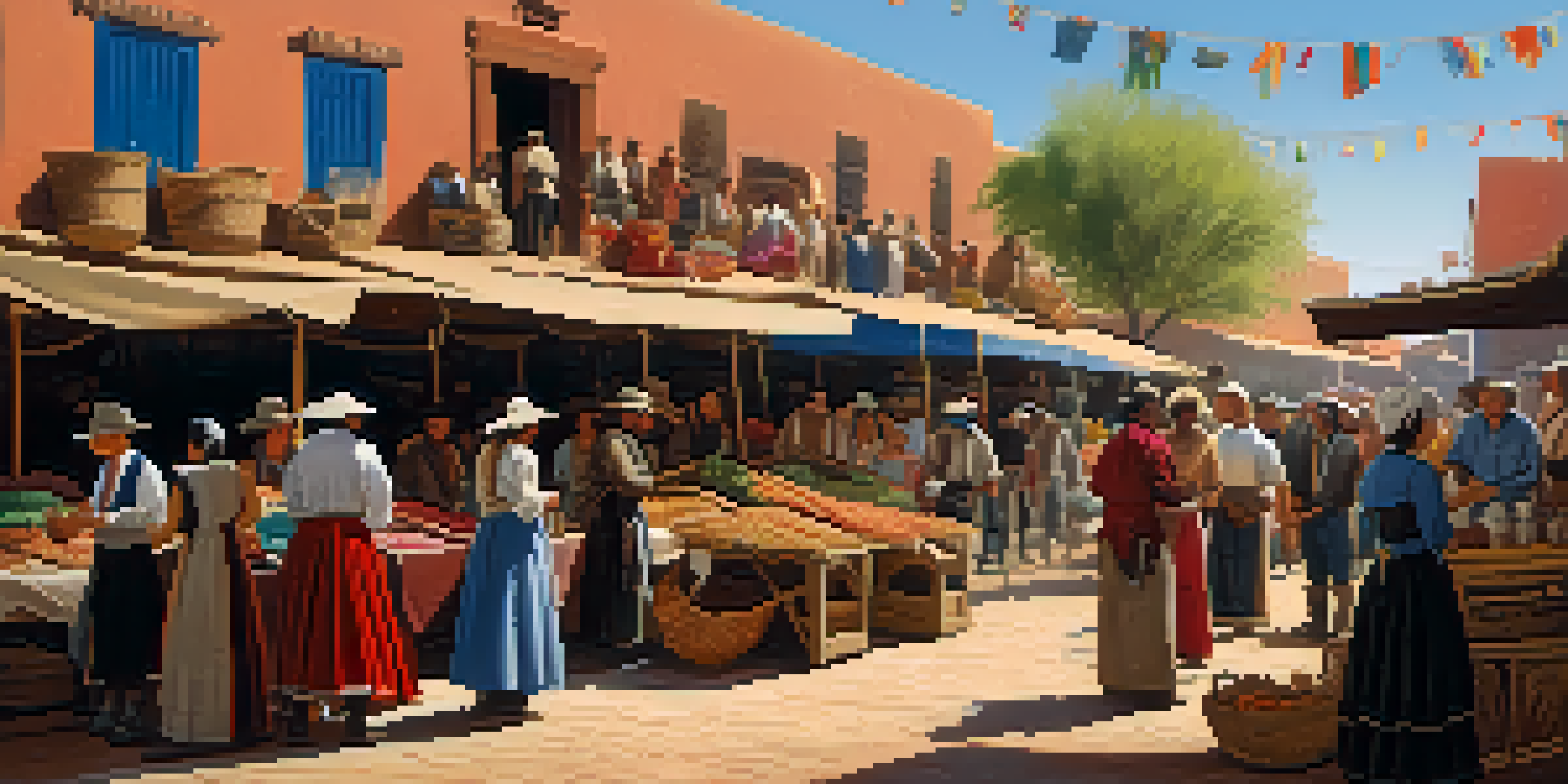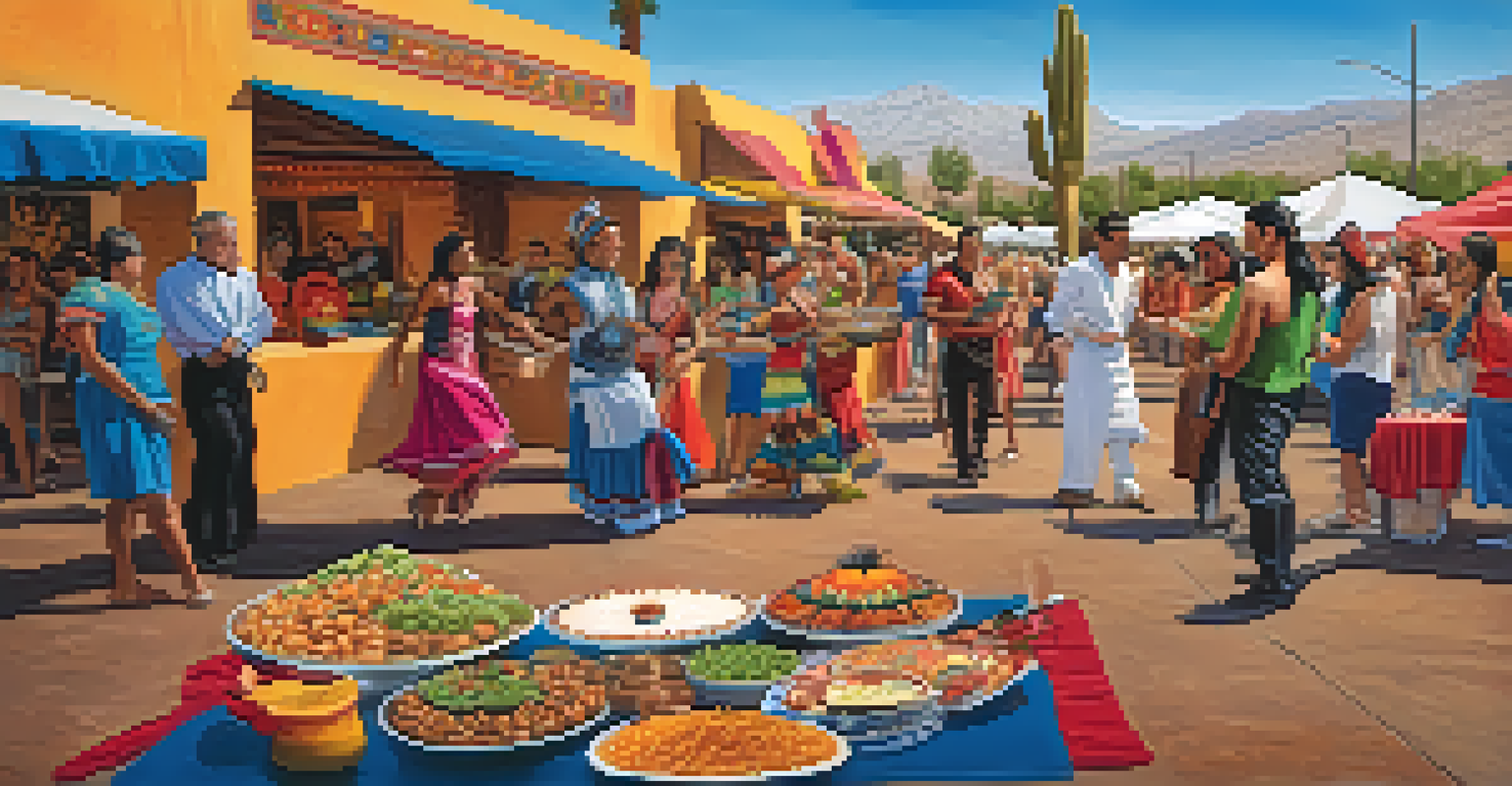Tucson's Role in Trade Routes During the Spanish Era

The Historical Context of Tucson's Trade Routes
During the Spanish Era, Tucson was more than just a settlement; it was a critical juncture for trade routes. Established in the late 18th century, Tucson's location made it an ideal stop for caravans traveling between Mexico and the American Southwest. The region's natural resources, including water and fertile land, attracted traders and settlers alike, fostering economic growth.
Trade is a bridge between cultures, fostering understanding and connection.
With the Spanish colonization efforts in full swing, Tucson quickly became a hub for the exchange of goods, ideas, and cultures. Traders would transport silver, textiles, and agricultural products, creating a bustling marketplace that connected diverse communities. The blending of Spanish and Indigenous cultures during this period also enriched the local economy and social landscape.
As trade flourished, Tucson's strategic importance grew, influencing both local and regional developments. The establishment of trade routes not only facilitated commerce but also played a pivotal role in the expansion of Spanish influence in the region. This laid the groundwork for Tucson's future as a key player in North America's trade networks.
Key Trade Goods and Their Impact
The trade routes that ran through Tucson were vital for the exchange of essential goods. Silver mined in Mexico was a primary commodity, flowing northward to meet the demands of various markets. In return, Tucson offered agricultural products and livestock, creating a symbiotic relationship that benefited both regions.

Textiles and manufactured goods were among other significant imports that found their way into Tucson. These items not only served practical purposes but also reflected the cultural exchanges that occurred during this time. The local economy thrived as these goods were traded, sold, and woven into the fabric of daily life in Tucson.
Tucson's Historical Trade Significance
Tucson's strategic location made it a vital trade hub during the Spanish Era, connecting diverse communities and fostering economic growth.
The movement of goods also led to the introduction of new agricultural practices and crops, enriching the local landscape. This exchange not only shaped Tucson's economy but also its identity, as it became a melting pot of cultural influences. The resulting diversity laid the foundation for the vibrant community we see today.
The Role of Indigenous Peoples in Trade
Indigenous peoples played an essential role in the trade dynamics of Tucson during the Spanish Era. They were not merely passive participants; many were active traders and intermediaries, facilitating exchanges between Spanish settlers and various tribes. Their local knowledge and established networks were invaluable assets in this bustling trade environment.
The past is not just a memory; it’s a living aspect of culture.
The interactions between Indigenous peoples and Spanish traders often led to the fusion of traditions and practices. This cultural exchange enriched both communities, as Indigenous groups introduced new farming techniques and crops that were adapted by the settlers. Such collaborations were crucial for survival and economic prosperity.
However, this relationship was complex, often marked by tension and conflict over land and resources. While trade fostered collaboration, it also highlighted the power dynamics at play. The long-term consequences of these interactions would shape Tucson's social fabric for generations to come.
The Influence of Spanish Military Presence
The establishment of Spanish military outposts in and around Tucson significantly impacted trade routes. These forts were not merely for protection; they also served as logistical hubs that facilitated the movement of goods and people. The military presence assured traders of relative safety, encouraging the flow of commerce.
Spanish soldiers often engaged in trade themselves, exchanging goods for services and support from local communities. This interaction further integrated Tucson into the broader Spanish trade network, linking it to larger markets. As a result, Tucson became a focal point not only for trade but also for military strategy in the region.
Cultural Fusion Through Trade
The exchange of goods in Tucson led to a rich blend of Spanish and Indigenous cultures, influencing local cuisine, traditions, and architecture.
The presence of the military also introduced new governance and regulations that shaped trade practices. While this provided structure, it also imposed restrictions that affected Indigenous trading practices. The military's influence fundamentally altered the landscape of trade in Tucson, embedding it deeper within the Spanish colonial system.
The Transition to American Trade Routes
As the Spanish Era came to a close, Tucson began transitioning into a new phase of trade under American influence. The Treaty of Guadalupe Hidalgo in 1848 marked a significant shift, as Tucson became part of the United States. This change brought new opportunities and challenges for local traders and communities.
The influx of American settlers and the establishment of new trade routes created a diverse economic environment. The demand for goods shifted, and Tucson adapted by incorporating different products and practices into its trade. This adaptability was crucial for the city’s survival and growth in a rapidly changing landscape.
Despite the challenges posed by this transition, Tucson's historical trade routes laid the groundwork for future economic development. The legacy of Spanish trade practices continued to influence local commerce, illustrating how history can shape modern economies. Tucson's evolving identity as a trade hub reflects its rich and complex past.
Cultural Legacies of Trade in Tucson
The trade routes established during the Spanish Era left lasting cultural legacies in Tucson. As goods and ideas flowed through the region, they brought with them traditions, cuisines, and customs that shaped local identity. The blend of Spanish and Indigenous influences is evident in everything from architecture to festivals celebrated today.
Cuisine is a particularly vivid example of this cultural fusion. Dishes that combine Native American ingredients with Spanish culinary techniques have become staples in Tucson's food scene. This rich tapestry of flavors not only tells the story of trade but also reflects the ongoing evolution of Tucson's cultural identity.
Modern Economic Resilience
Tucson's historical trade routes continue to inform its diverse economy today, showcasing the city's adaptability and cultural heritage.
These cultural legacies continue to thrive, showcasing the importance of preserving history while embracing change. The traditions born out of these trade routes are celebrated in various forms, reminding residents and visitors alike of Tucson's dynamic heritage. The past is not just a memory; it’s a living aspect of the city's culture.
Modern Implications of Tucson's Trade History
Understanding Tucson's role in historical trade routes has modern implications that resonate today. As a city that once thrived on trade, Tucson continues to be a hub for commerce in Southern Arizona. The lessons learned from its past can inform current economic strategies and practices.
Today, Tucson's diverse economy reflects its historical roots, blending agriculture, tourism, and technology. The spirit of trade and collaboration remains strong, as local businesses draw inspiration from the rich tapestry of cultures that have shaped the city. This continuity of trade fosters resilience and innovation in the modern marketplace.

By recognizing and honoring its historical significance, Tucson can leverage its unique identity to attract investment and tourism. The story of its trade routes is a testament to the city’s adaptability and strength, reminding residents of the importance of community and connection in a globalized world.